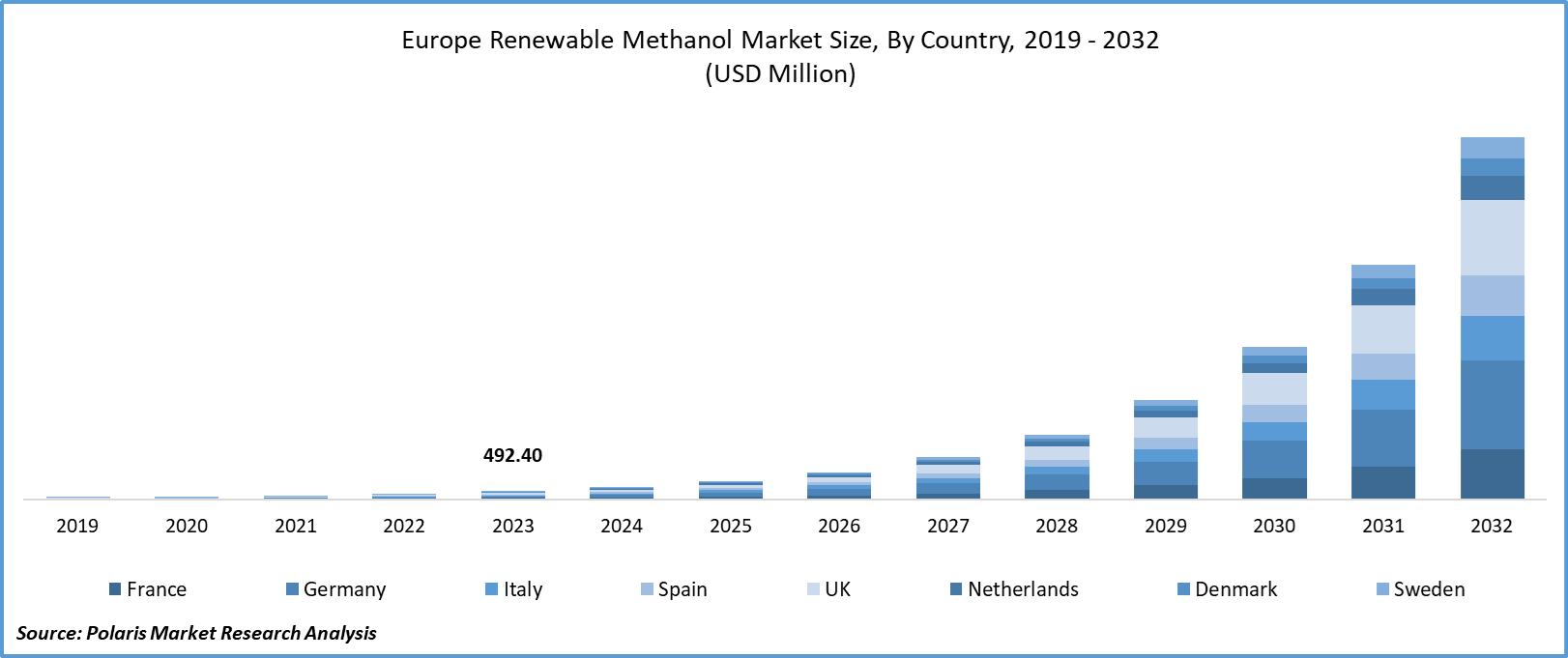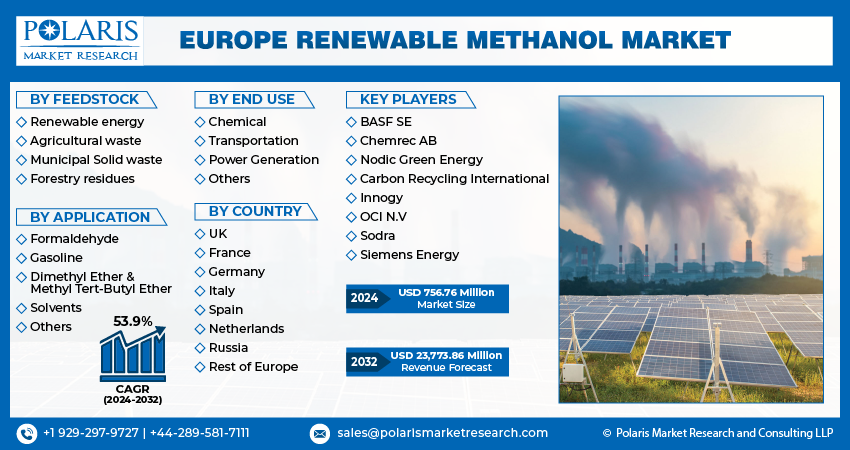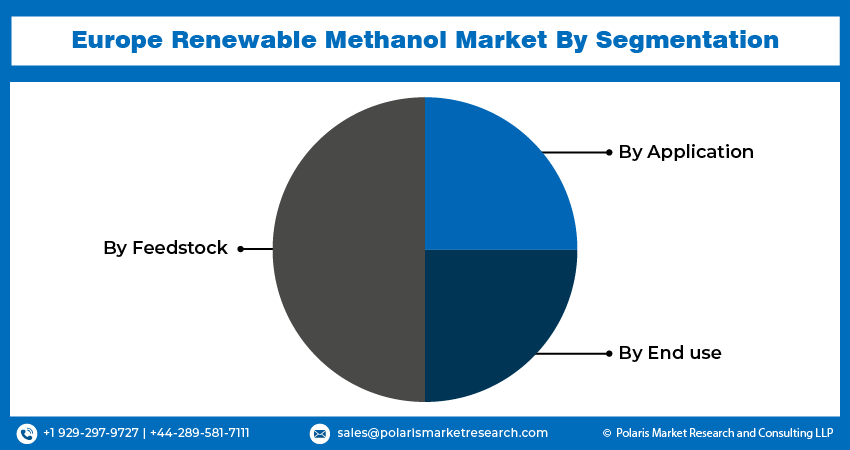
Europe Renewable Methanol Market Share, Size, Trends, Industry Analysis Report, By Feedstock (Renewable energy, Agricultural waste, Municipal Solid waste, Forestry residues); By Application; By End Use; By Country; Segment Forecast, 2024 - 2032
- Published Date:May-2024
- Pages: 119
- Format: PDF
- Report ID: PM4901
- Base Year: 2023
- Historical Data: 2019-2022
Report Outlook
Europe renewable methanol market size was valued at USD 492.40 million in 2023. The market is anticipated to grow from USD 756.76 million in 2024 to USD 23,773.86 million by 2032, exhibiting the CAGR of 53.9% during the forecast period.
Industry Trends
The Europe renewable methanol market has witnessed significant growth in recent years, driven by the increasing adoption of methanol as a versatile liquid chemical that finds its application. However, the emergence of renewable methanol has brought about a revolutionary shift in the industry. Renewable methanol, also known as bio-methanol, is an ultra-low carbon chemical derived from sustainable biomass or through the combination of CO2 and hydrogen obtained from renewable electricity. The production of renewable methanol is not limited to specific regions, as it can be sourced from a diverse range of renewable feedstocks available. Additionally, the process of harvesting trees yields a substantial amount of residual biomass, including leaves, branches, needles, and woodchips, which can serve as valuable feedstocks for the production of renewable methanol.

To Understand More About this Research:Request a Free Sample Report
Swedish company Södra is actively involved in utilizing the raw methanol derived from its pulp mill manufacturing to produce renewable methanol. Once operational, the plant is projected to yield an impressive 5,000 metric tons of bio-methanol annually, resulting in a remarkable 99% reduction in CO2 emissions compared to fossil fuels.
One of the prominent market trends shaping the Europe renewable methanol market is the rising adoption of technologies aimed at decreasing the carbon intensity of methanol derived from natural gas, known as Low Carbon Methanol (LCM), over the past few years by numerous companies. They have created Various large-scale technologies for producing LCM from natural gas, resulting in comparable emission reductions. Johnson Matthey, a British multinational specializing in chemicals and sustainable technologies, with its headquarters located in London, England, has introduced a method called Advanced Combining Reforming, which generates LCM through the use of renewable electricity.
Key Takeaways
- Germany dominated the market and contributed over 22% of the market share
- By feedstock category, the renewable energy segment accounted for the largest Europe Renewable Methanol market share
- By application category, the formaldehyde segment dominated the market and gasoline segment is anticipated to grow with a lucrative CAGR over the Europe Renewable Methanol market forecast period.
What are the market drivers driving the demand for market?
Technological advancement drives the European renewable methanol market growth.
The market is experiencing significant growth due to the escalating demand for low-carbon fuels in the energy transition has sparked a growing interest in methanol production from renewable energy sources. CO2 hydrogenation typically carried out in fixed-bed catalytic reactors at 250–300 °C and 50–100 bar, is currently the most promising technology for commercial scale development of renewable methanol in Europe. The power-to-methanol approach offers a dual benefit: it enables the storage of renewable electricity in chemical form while producing a fully renewable product that can substitute fossil-derived fuels. E-methanol and its derivatives are appealing options for the transportation sector due to their cleanliness and compatibility with existing distribution and storage infrastructures used for conventional oil-based transport fuels.
Which factor is restraining the demand for market?
High production cost affects the Europe Renewable Methanol Market
The production cost in the European market is highly competitive. Although e-methanol is currently more expensive than fossil-derived methanol, it is anticipated that the cost will decrease in the long run, making it comparable to the current production cost of fossil fuels. This reduction in e-methanol production cost can be attributed to the decrease in electricity prices, which account for a significant portion (40-70%) of the overall production cost. Additionally, the optimization of the conversion chain, particularly through the development of advanced copper/zinc-based catalysts for CO2 hydrogenation and the economy of scale resulting from the widespread adoption of advanced electrolyzers, are expected to play a crucial role in driving down costs.

Report Segmentation
The market is primarily segmented based on feedstock, application, end use, and country.
|
By Feedstock |
By Application |
By End use |
By Country |
|
|
|
|
To Understand the Scope of this Report:Speak to Analyst
Category Wise Insights
By Feedstock Insights
Based on feedstock analysis, the market is segmented into renewable energy, agricultural waste, municipal solid waste, and forestry residues. The renewable energy segment has dominated the market, and the agricultural waste segment is anticipated to grow at the fastest CAGR over the forecast period. Renewable energy production and consumption in the EU have experienced a significant surge due to the implementation of dedicated policies and measures, as well as the rapid advancement of technology. Renewable methanol, a chemical derived from sustainable biomass, is an excellent example of renewable energy. In comparison to traditional fuels, renewable methanol boasts a remarkable reduction of up to 95% in carbon dioxide emissions and up to 80% in nitrogen oxide emissions. It eliminates sulfur oxide and particulate matter emissions.
By Application Insights
Based on application analysis, the market has been segmented into formaldehyde, gasoline, dimethyl ether & methyl tert-butyl ether, solvents, others. The formaldehyde segment accounts for the largest and the gasoline segment accounts for the fastest growing market share in Europe’s renewable methanol market. Formaldehyde and formaldehyde-releasing substances are produced and utilized across various sectors within the EU.
Formaldehyde serves primarily as a chemical intermediary for the production of formaldehyde-based resin and other chemicals that exhibit competitiveness, durability, quick drying times, and strong resistance to water and chemicals. Alkyd resins are present in architectural coatings such as paints and finishes for automotive products. Formaldehyde is predominantly employed in the manufacturing of items like wood-based products, furniture, wall coverings, foams, and textiles, which have the potential to emit formaldehyde when in use.
By End Use Insights
Based on end-use analysis, the market has been segmented into chemical, transportation, power generation, and others. The chemical segment accounts for the largest market share, and the power generation segment is anticipated to grow at the fastest CAGR over the forecast period. Renewable methanol presents a viable solution for reducing harmful emissions. In Israel, a 50 MW plant successfully transitioned from light fuel oil to methanol, resulting in the complete elimination of sulfur oxide emissions. Additionally, nitrogen oxide and particulate matter emissions were significantly reduced by 85% and 90%, respectively.
This transition to renewable methanol not only benefits nations heavily reliant on diesel generators by offering cost savings, but it also has the potential to contribute to grid stability. By utilizing excess renewable electricity to power electrolysis, a crucial step in renewable methanol production, the resulting clean and renewable methanol can be used as a reliable fuel source for power plants, ensuring energy availability whenever needed.

Country-wise Insights
Germany
Germany leads the Renewable Methanol market in Europe, and the UK is anticipated to grow with the fastest CAGR over the forecast period. Germany, as a country, is committed to environmental sustainability and the utilization of renewable energy. Methanol is acknowledged as a flexible and more environmentally friendly fuel in contrast to conventional fossil fuels, aligning with Germany's objectives to diminish greenhouse gas emissions and shift towards cleaner energy alternatives. However, in the UK, the growth is driven by the adoption of methanol as a substitute marine fuel and the prevalence of coal as a raw material.
Competitive Landscape
The competitive landscape for the European renewable methanol market is characterized by intense rivalry, swift technological progress, and the necessity to adjust to changing market dynamics. Key players striving to gain market share and differentiate themselves through innovation and strategic partnerships. Amidst this landscape, collaboration between companies for technological advancements, innovation and implementation of the same in practical world remains crucial for driving expansion of the market, and addressing evolving needs for sustainability in the European renewable methanol market.
Some of the major players operating in the European market include:
- BASF SE
- Chemrec AB
- Nodic Green Energy
- Carbon Recycling International
- Innogy
- OCI N.V
- Sodra
- Siemens Energy
Recent Developments
- In April 2024, Ansasol, a developer of solar and renewable hydrogen from Germany and Spain, announced intentions to construct a large 800MW green hydrogen-to-methanol facility in the south of Spain, with the capacity to produce one million tons of green methanol annually by 2029.
- In February 2024, Evergreen Marine and X-Press Feeders will introduce the inaugural European green methanol-powered feeder network. The choice to incorporate dual-fuel ships running on green methanol is a crucial component of X-Press Feeders' commitment to decrease its greenhouse gas emissions (CO2e) by 20% by 2035 and 50% by 2040 and achieve carbon neutrality by 2050.
- In July 2023, Mitsui invested in Denmark's pioneering e-methanol Production & Sales Business, aiming to capitalize on its proficiency in chemicals, renewable energy, shipping, and various other sectors, intended to boost the competitiveness of the Kasso business by leveraging Mitsui's experience in the current methanol production and sales industry. Additionally, Mitsui plans to strengthen its strategic alliance with EE through Kasso.
Report Coverage
The Europe renewable methanol market report emphasizes on key countries across the region to provide better understanding of the product to the users. Also, the report provides market insights into recent developments, trends and analyzes the technologies that are gaining traction around the region. Furthermore, the report covers in-depth qualitative analysis pertaining to various paradigm shifts associated with the transformation of these solutions.
The report provides detailed analysis of the market while focusing on various key aspects such as competitive analysis, component, application, organization size, vertical, and their futuristic growth opportunities.
Europe Renewable Methanol Market Report Scope
|
Report Attributes |
Details |
|
Market size value in 2024 |
USD 756.76 million |
|
Revenue forecast in 2032 |
USD 23,773.86 million |
|
CAGR |
53.9% from 2024 – 2032 |
|
Base year |
2023 |
|
Historical data |
2019 – 2022 |
|
Forecast period |
2024 – 2032 |
|
Quantitative units |
Revenue in USD million and CAGR from 2024 to 2032 |
|
Segments covered |
By Feedstock, By Application, By End Use, By Country |
|
Regional scope |
UK, France, Germany, Italy, Spain, Netherlands, Russia, Rest of Europe |
|
Customization |
Report customization as per your requirements with respect to countries, region and segmentation. |
FAQ's
The Europe Renewable Methanol market size is expected to reach USD 23,773.86 million by 2032
Key players in the market are BASF SE, Chemrec AB, Nodic Green Energy, Carbon Recycling International, Innogy
Europe renewable methanol market , exhibiting the CAGR of 53.9% during the forecast period.
The Europe Renewable Methanol Market report covering key segments are feedstock, application, end use, and country.
